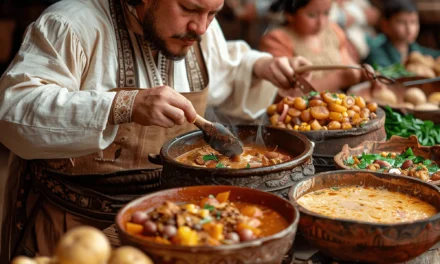Ceviche is an incredible dish that goes way back – think a really ancient ancestor. It’s thought to have originated from South America’s north coast, where locals would marinate raw fish pieces, such as cubes or thin slices, in a heavenly blend of citrus juice and other acidic liquids. They’d also toss a few aromatic seasonings to add a little extra zing, like tasty onions and chili peppers. This process is like magic as it denatures and coagulates the fish’s proteins, creating a taste and texture masterpiece1.
Fish-on-Fruits Frenzy: Peruvian Ceviche from the Mochica Culture
It is believed that way back in the day, on the Peruvian coast, the Mochica culture was known for their creative home cooking involving fish and the juice of local fruit, otherwise known as tumbo. Historians can’t seem to agree on exactly where this delicious dish originated from, but all the speculation points to that cheeky, world-renowned chef, the Moche culture. They were the first to marinate their fish in tumbo juice with a pinch of salt and chili2.
It’s no wonder that the Incan people enjoyed their fish! So much so that they decided to kick it up a notch by macerating it with chicha. They must have thought they’d hit the jackpot with this tasty combination! But it wasn’t until the arrival of the Spaniards that the classic ingredients that we know and love today in ceviche – lemon, onion, the works – were added. The grand finale? The delicious term ‘seviche’ comes from the word ‘siwichi’ in the Quechua language – which literally translates as fresh and tender fish.
Taste the Tangy Potion of Escabeche
Ceviche is like a tangy, vinegar-spiked glass of sunshine that’s here to brighten up your day! This zesty dish comes from the Arabic word iskebêch, which is Persian for “pickled”3.
The first appearance of “escabeche” is in the Almohad Manuscript of the 13th century: “(…) young meat is taken, cut and placed in a pot. Vinegar is added (…) raisins, pepper, dried coriander (…) onion mashed with green coriander, salt, and a clove of garlic…3
The Moorish women, taken as prisoners of war and shipped to Peru, were the masterminds behind a world-renowned dish for its flavor and zing. It was like they took ordinary raw fish and applied the culinary equivalent of a magic wand. First, they added a splash of tart orange juice for some added zing, followed by a few squeezes of zesty lemon juice. Then, a hit of hot chili pepper gave it just the right amount of kick, and seaweed, like a tasty cherry on top, rounded out this delicious dish that the pre-Hispanic Peruvians had never tasted before3.
On the west coast of South America, from the Equator to the south, people had a tasty treat of raw fish that would later become famous as Peruvian ceviche! It was first recorded by the brave expedition of Francisco Pizarro, arriving at Atacames in 1531, according to Captain Juan Cabezas’s report. Even though ceviche wasn’t invented yet, they still had a way of giving the fish a zesty flavor by substituting the acidity of plants with the more prominent lemon, which didn’t exist before Spanish colonization4.
Ceviche: A Cultural Legacy Comes to Life
Ceviche comes from the word “cebo” (bait or small slices of fish), which was the derogatory tone during the XVI century. They referred to the dish for its low value because it was raw and small. The hypothesis belongs to Federico More, a Peruvian essayist, and was published for the first time in 1952 in the newspaper El Comercio3.

As for the dish itself, Japan has a similar dish called “Poke” which is like a water party for raw seafood, soaking it in various sauces. When the Japanese decided to uproot and make the voyage to Peru in the late 18th and 19th centuries, it was a veritable cultural revolution for the humble ceviche. It was as if the ceviche found a fresh breath of new life, taking on a whole new flavor as the Japanese folks brought along their own unique recipes and flavors to this already flavorful food5.
The Peruvian Government pulled out all the stops this year when they chose June 28th to officially declare it the Day of Seviche! We all know that there’s nothing quite like this delicious dish of raw fish marinated in lemon and chili pepper to make your taste buds go wild! It’s also a great reminder that since 2004, this beloved dish has taken its place as part of Peru’s proud Cultural Heritage6.
- McGee, H. (2011). La Cocina y Los Alimentos (Sexta ed.). (J. M. Ibeas, Trad.) Barcelona, España: Debate.[↩]
- Ramírez R., D. (2018, December 26). Patrimonio cultural: Ceviche peruano. Retrieved from Gastronomia.com Peru: https://peru.gastronomia.com/noticia/8487/patrimonio-cultural-ceviche-peruano[↩]
- Terrés, J. (2016, June 9). El ceviche es español (lo sentimos, Perú). Retrieved from Condé Nast Traveler: https://www.traveler.es/gastronomia/articulos/origen-ceviche-peruano-espanol/8991[↩][↩][↩][↩]
- Patiño, V. M. (Octubre de 1990; 2012). Historia de la cultura material en la América equinoccial: I. Alimentación y alimentos. Obtenido de Ministerio de Cultura: https://www.mincultura.gov.co/Sitios/patrimonio/bibliotecas-de-cocinas/tomos/tomo01.pdf[↩]
- Hatlestad, K. (2017, March 15). Peruvian Food: the Social and Cultural Origins of Peruvian Food. Retrieved from Portland State University: https://pdxscholar.library.pdx.edu/cgi/viewcontent.cgi?article=1438&context=honorstheses[↩]
- EFE. (2008, September 18). Perú decreta el 28 de junio como el Día del Seviche. Retrieved from El Pais: https://elpais.com/internacional/2008/09/19/actualidad/1221775203_850215.html[↩]




